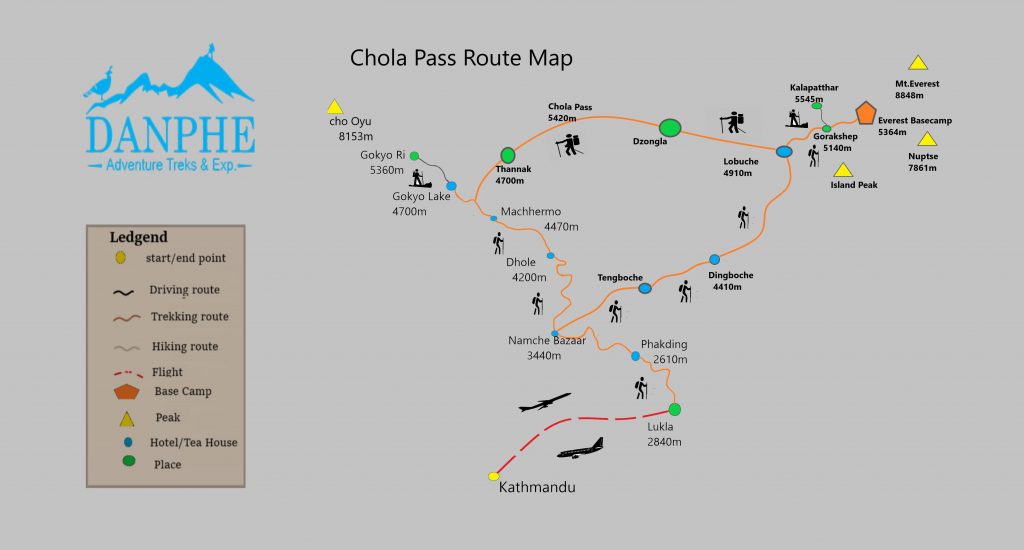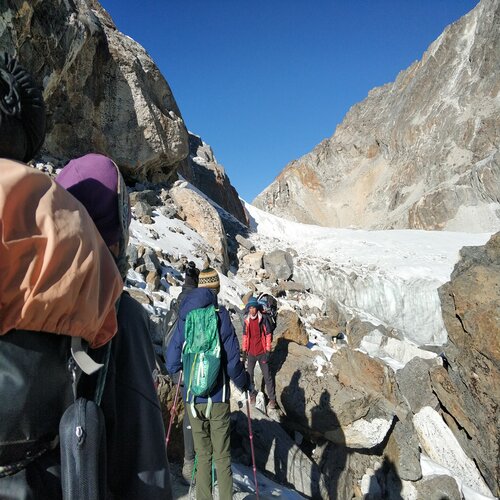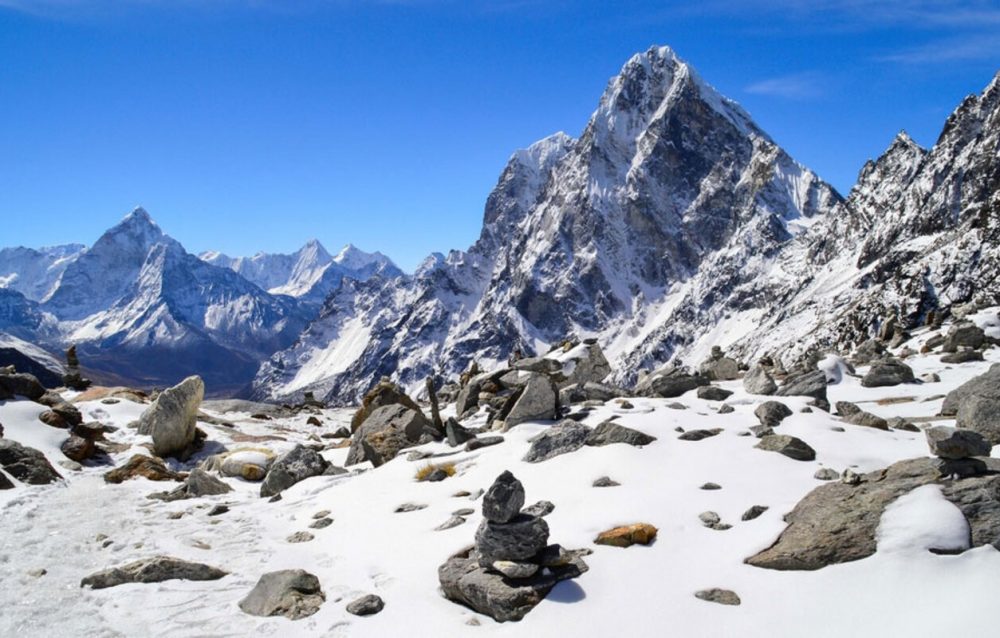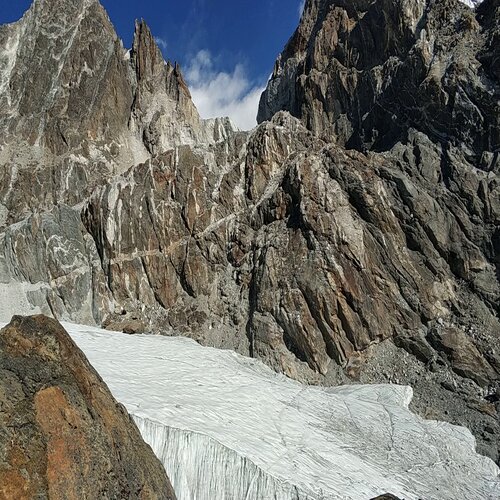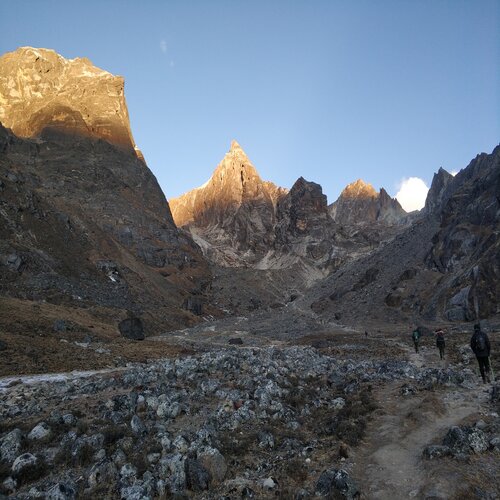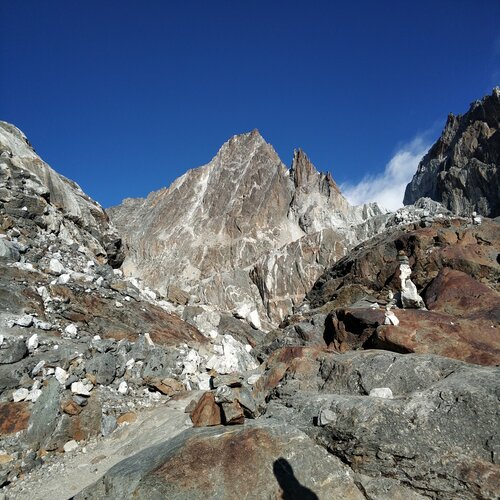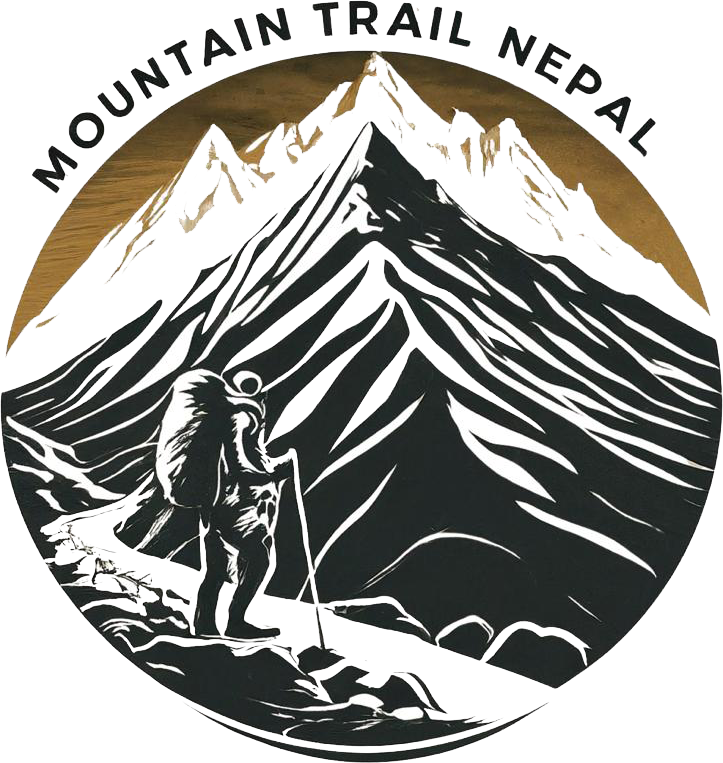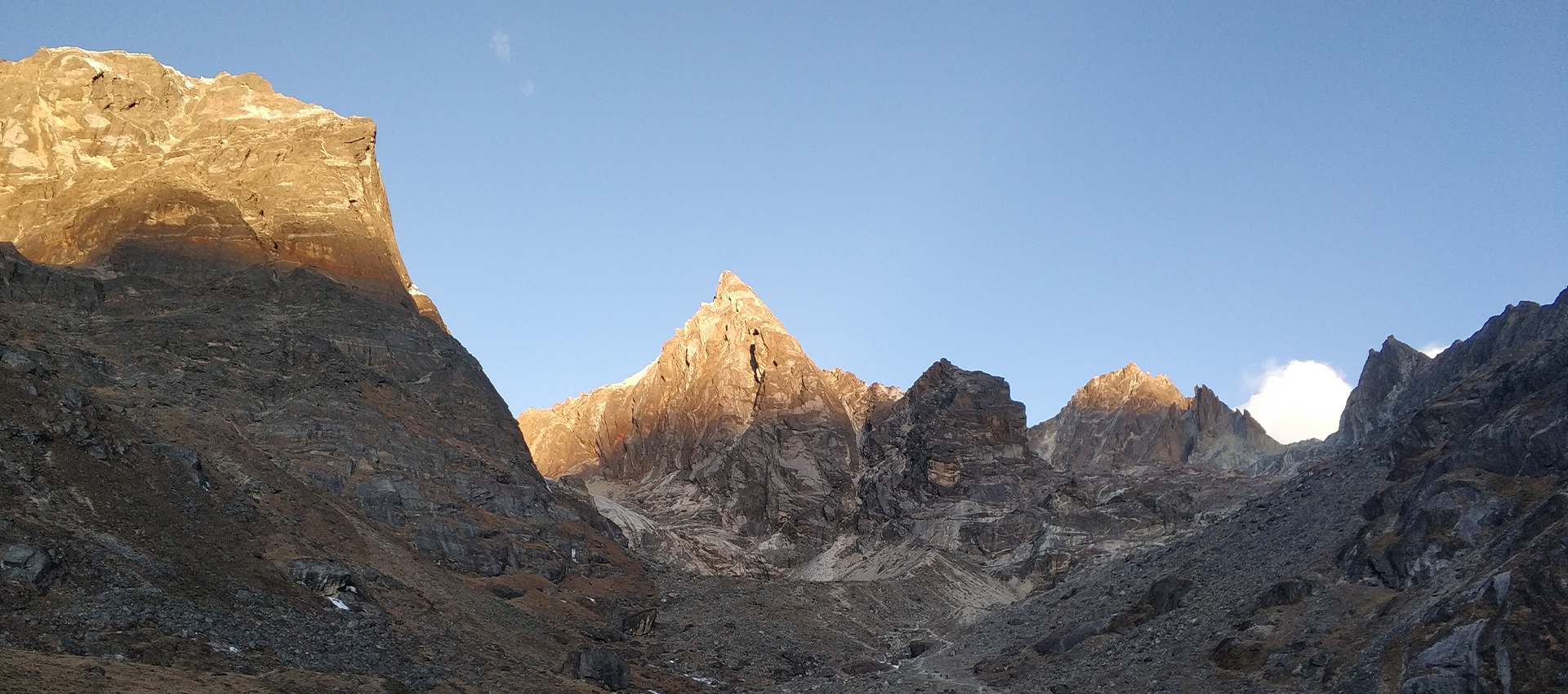Trip Highlights
- Experience the serene beauty of Gokyo Lakes and hike up to Gokyo Ri for breathtaking views at 5360 meters.
- Marvel at panoramic vistas of Mt. Everest (8848m), Lhotse (8414m), and Ama Dablam (6856m) from the Kalapatthar viewpoint.
- Immerse yourself in the rich Sherpa culture, traditions, and lifestyle throughout the journey.
- Explore the iconic Everest Base Camp (5364m) and soak in the stunning surroundings.
- Challenge yourself by crossing the Chola Pass (5420m), one of the highest passes in the Everest region.
- Traverse through the Sagarmatha National Park, home to incredible biodiversity and stunning landscapes.
Trip Itinerary
Expand All
Shrink All
-
Day 01 : Kathmandu Arrival (1300m)
When you land at Tribhuvan International Airport, our staff will be there to greet you and take you to your hotel. Once you’re checked in, you can take a walk around the area near your hotel to see what daily life is like in Kathmandu. You’ll spend the night at the hotel in Kathmandu.
-
Day 02 : Kathmandu full day sightseeing
Today, you’ll explore some important places in Kathmandu. You’ll visit UNESCO World Heritage Sites like Swayambhunath, Pashupatinath, and Boudhanath. These sites have beautiful buildings with unique designs. You’ll also see Kathmandu Durbar Square. After visiting these places, you’ll go back to your hotel. You can use the rest of the day to get ready for the trek. You’ll spend the night at the hotel in Kathmandu.
-
Day 03: Fly to Lukla (2840m) | 30 mins and trek to Phakding (2610m) | 3 hrs
Today, we have an early morning flight to Lukla, which is the starting point for our trek to the Everest region. When we arrive in Lukla, we gather all our trekking gear and begin walking towards Phakding. Along the way, we enjoy beautiful views of Mount Khumbila (5761m). We continue walking downhill until we reach Phakding, where we will spend the night.
-
Day 04 : Trek from Phakding to Namche Bazaar (3440m) | 6 hrs
Today, we walk through pine forests and then head north into the Bengkar valley. We follow the Dudh Koshi River and pass through Monjo before reaching the entrance of Sagarmatha National Park. Crossing suspension bridges, we arrive at the village of Jorsalle. Climbing some steep trails, we finally reach the largest settlement in this area, Namche Bazaar, where we will spend the night.
-
Day 05: Rest and acclimatization day at Namche
Today is a day for getting used to the altitude, so we won’t be doing any strenuous trekking. Instead, we’ll explore the town and its surroundings. You can hike up to the Everest View Hotel to see the amazing view of Mount Everest (8848m) and other peaks in the Everest range. You can also visit the villages of Khumjung and Khunde to learn about the Sherpa culture and lifestyle in the Khumbu Valley. We’ll spend the night in Namche Bazaar.
-
Day 06: Trek from Namche Bazaar to Tengboche (3860m) | 5-6 hrs
The trail starts off easy, but then it gets steep as we make our way to the Tengboche village. This village is home to the Tengboche Monastery, which is the largest monastery in the Everest region. From there, we can see stunning views of the mountains in the Khumbu region, including many peaks in the Everest massif. After visiting the monastery, we’ll go to our lodge in the Tengboche village for the night.
-
Day 07 : Trek from Tengboche to Dingboche (4410m) | 6-7 hrs
We walk through lush forests and see birch trees along the trail. Along the way, we can see Mount Everest (8848m), Lhotse (8414m), and Ama Dablam (6856m) in the distance. We continue downhill and cross the Imja River to reach Pangboche. After visiting the Pangboche Monastery, we follow the Imja valley and climb up to reach Dingboche, where we’ll spend the night.
-
Day 08: Acclimatization day at Dingboche
Today is a day to rest and adjust to the altitude. We won’t be doing much trekking. Instead, we can climb the ridge behind the village to see mountains like Lhotse (8414m), Makalu (8463m), and Cho Oyu (8188m). We can also see mountains to the northwest that rise above the Khumbu Khola valley. If you prefer, you can explore the village and try some local food. We’ll spend the night in Dingboche.
-
Day 09: Trek from Dingboche to Lobuche (4910m) | 5-6 hrs
Today, we continue our trek through the valley, passing through Dughla and Pheriche. The path gets a bit higher, so we need to be careful as we walk. We’ll encounter rocky paths with some snow and not many plants. We’ll be surrounded by the big peaks of the Khumbu region as we walk. After a few hours, we’ll arrive at Lobuche, where we’ll spend the night.
-
Day 10 : Trek to Everest base camp (5364m) via Gorakshep (5140m) | 8-9 hrs
We walk through meadows and see the impressive Khumbu glacier. Ahead is Kalapatthar, a famous spot for seeing the Everest region. After reaching Gorakshep, we hike to the Everest Base Camp. It’s a tough climb, but once we get there, we enjoy the view of the Khumbu glacier. We’ll spend the night at Everest Base Camp.
-
Day 11: Hike to Kalapatthar (5545m), trek to Dzongla (4830m) | 7-8 hrs
Walking on the snowy ground is tough and cold. We get to see big mountains like Lingtren and Khumbutse, and sometimes even Mount Everest (8848m). When we reach Kala Patthar, we see the whole Khumbu region. Then we walk downhill to Dzongla. It’s a steep path, but we finally arrive in Dzongla where we can see mud houses. We’ll spend the night there.
-
Day 12: Trek from Dzongla- Cho la pass- Thannak
Today will be one of the toughest days of our trip. After breakfast, we’ll start trekking to cross the Chola Pass (5370m). It’s steep and involves walking on trails with glaciers. But once we reach the top, we’ll see amazing views of mountains like Ama Dablam, Kantaiega, Thamserku, Cholatse, Taboche, and more on the Gokyo side. We’ll need to pass through some crevasses before reaching Thannak. We’ll spend the night there.
-
Day 13: Trek from Thannak to Gokyo (4790m.)3 hrs. Visit 5th lake (4990m.) and back to Gokyo 5 hrs
After breakfast, we start our trek. Today will be a short hike as we cross the Ngozumpa Glacier, which is the longest glacier in Nepal. We’ll also pass by shifting trails and some frozen lakes. Along the way, we’ll explore Dudh Pokhari, the largest lake in the region, which has a total of 6 lakes. The lake is beautiful and offers magnificent views of the mountains. Enjoying the stunning scenery, we’ll continue our journey to Gokyo Village. The village is located near the third lake, Gokyo. We’ll spend the night in Gokyo.
-
Day 14: Hike to Gokyo Ri (5360m) and trek down to Dhole (4110m) | 6-7 hrs
The hike to the summit of Gokyo Ri (5360m) is challenging and may take some time. Along the trail, we’ll enjoy the views of Gokyo village, with Cholatse (6335m) and the Ngozumpa glacier in the background. After soaking in these breathtaking sights, we’ll trek back down on a steep descent that leads us to Dhole. It’s important to be careful on the steep downhill trail. We’ll spend the night in Dhole.
-
Day 15 : Trek from Dole to Namche Bazaar (3440m) | 5-6 hrs
Today’s trail begins with a descent towards Phortse Tenga. Along the way, we notice less snow and start seeing some plants. We then face a steep climb up to Mong la Danda, where we’re rewarded with beautiful views of the snowy mountains. After that, we descend to Kyangjuma and continue on a relatively easier path until we reach Namche. We’ll spend the night in Namche.
-
Day 16: Trek from Namche Bazaar to Lukla (2840m) | 6-7 hrs
Today’s trek starts with rocky terrain. We mostly walk downhill alongside the Dudh Koshi River. The river is clean and refreshing. We’ll cross several suspension bridges and pass by monasteries along the way. Finally, we’ll reach Lukla where we’ll stay for the night.
-
Day 17: Fly back to Kathmandu (1300m) and Farewell dinner
From Lukla, you’ll board a short 30-minute flight to Kathmandu. During the flight, you’ll enjoy breathtaking views of the Khumbu region’s majestic mountains. Once you land in Kathmandu, you’ll be transferred to your hotel. In the evening, you can enjoy dinner with your companions. You’ll spend the night at the hotel in Kathmandu.
-
Day 18: Free day and farewell dinner
Today is a spare day, just in case anything unexpected happens during the trek. If everything goes smoothly, you’ll have the day to explore Kathmandu. You might take a tour around the city, checking out its sights and sounds. Later, enjoy a tasty dinner arranged by the company, and bid farewell to your fellow travelers. You’ll spend the night at the hotel in Kathmandu.
-
Day 19: Departure to international airport for your final flight
What's Included
- Private airport transfers in a comfortable vehicle for arrival and departure.
- Accommodation in Kathmandu with breakfast included, as per the itinerary.
- Guided cultural tour of Kathmandu with a knowledgeable guide and private vehicle.
- All meals (Breakfast, Lunch, and Dinner) provided during the trek.
- Comprehensive ground and air transportation arrangements throughout the trek.
- Experienced, English-speaking guide and porter ratio of 1 porter for every 2 trekkers.
- Staff salaries covering their food, accommodation, and transportation expenses.
- Arrangement of all necessary permits, including Conservation entry permits and TIMS card.
- Emergency helicopter service arrangement, covered by your travel insurance.
- Provision of essential trekking equipment, including sleeping bag, down jacket, and trekking map (to be returned after the trek).
- Inclusive of all government taxes, VAT, and local taxes for a hassle-free experience.
- Nepal entry visa fee ($25 USD), obtainable upon arrival at Tribhuwan International Airport in Kathmandu. Please prepare 2 passport size photos.
- International airfare to and from Kathmandu.
- Compulsory travel insurance covering the duration of your trip.
- Meals in Kathmandu, giving you the flexibility to explore local dining options.
- Entry fees for cultural tours and attractions during your stay in Kathmandu.
- Personal expenses such as alcoholic and non-alcoholic beverages, bar bills, battery charges, additional porter services, and hot water showers.
- Tips for your guide, porter, and driver, which are discretionary but highly appreciated for their excellent service
Equipment List
List of Equipments required for Chola Pass Trek:
Head:
- Warm winter hat/beanie
- Sun hat
- Headband/buff
- Sunglasses with UV protection
- Headlamp/Torch with extra batteries
Upper Body:
- Light fleece sweater
- Heavy fleece sweater
- Quick-drying long-sleeved base layer shirts (2 pairs)
- Short sleeve trekking shirts (3 pairs)
- Wind/rainproof jacket
- Down jacket
Lower Body:
- Trekking shorts
- Trekking trousers
- Lightweight thermal bottoms (seasonal)
- Trekking pants with zip-off bottoms (2 pairs)
- Fleece or woolen trousers
- Waterproof pants
Hands:
- Lightweight warm gloves
- Poly-liner gloves
Feet:
- Trekking boots
- Sandals/trainers (for wearing around the lodges)
- Down booties
- Thin lightweight inner socks (2 pairs)
- Warm woolen or poly socks (2 pairs)
- Gaiters (only in winter)
Other:
- Sleeping bag
- Sleeping bag liner (optional)
- Trekking poles (1 pair)
- Water purification tablets/Steripen/drops
- Quick-drying towel
Feel free to adjust this list based on your personal preferences and the specific requirements of your trek. It’s essential to ensure you have the necessary gear to stay comfortable and safe during your adventure in the Nepalese mountains.
FAQs
-
What are the visa requirements?
Currently, all the foreign nationalities (except Indians) require a visa to enter Nepal. Visas are obtainable from embassies abroad or on arrival at Kathmandu’s Airport. If getting the visa at the airport be prepared for long queues. You will also need to provide one passport photo and the $50 USD fee for 30 days.
-
What are the physical requirements for Chola Pass Trek?
Chola Pass Trek requires you to trek at an altitude of a maximum of 5545m and up to 5- 8 hours per day, with a small 5-7kg bag. We recommended you to train with long hikes and/or a sport of your choice (e.g. jogging).
-
How old do I need to be?
There is no age restriction for doing this trip, but if you are under 16 it will better to trek with your parents. You must be health-conscious during the trek.
-
What is included?
Included:
- Guides and Porters
- Transportation (including airport transfers)
- Accommodation
- Permits & national park fees
- Sightseeing tour in Kathmandu
- All meal during the trek
- Seasonal fruits
Excluded:
- International flights to Kathmandu
- Food – (while you are in City)
- Showers on Trek
- Tips
- Visa fees (typically $50 USD)
- Personal travel/rescue insurance
-
What is the situation with the internal flight while going for Chola Pass Trek?
Flights go from Ramechhap to Lukla. Because of the ever-changing weather, your internal flight may be canceled or delayed for safety reasons. In this instance, your guides will book you onto the next available and safe flight at no extra cost. You will be required to pay for accommodation at the hotel for any additional nights not noted on the itinerary. All local flights (excluding helicopters) are included in the cost of your trek unless otherwise noted. It is important that you provide your passport information at the time of booking in order to process these tickets. Internal flight tickets are issued locally and will be given to you prior to the flight departure.
In the event that the flights are canceled on days 3 and 4 of your itinerary and no helicopters are available, it will not be possible for you to ascend to Chola Pass safely and with the required acclimatization stops.
In the unlikely event that the above does happen, the group will be taken on the Annapurna Base Camp trek. This requires no internal flights. Annapurna Base Camp is also a 16-day itinerary which reaches a maximum altitude of 4,130m, starting in the beautiful city of Pokhara.
-
Can I use a helicopter if I need to?
To be sure that you make your trek, or return from it, it may be necessary to make the flight to/from Lukla by a chartered helicopter. Helicopters can operate in some weather that aircraft cannot. Should a helicopter be needed, it will be at the expense of the travelers. Please seek further advice about this from your insurance provider.
Hopefully, weather delays will not occur, or if they do it will be for a limited time. Should the delays stretch into days and neither helicopter nor flight are a viable option, a collective decision will be made by the group on how to proceed.
-
What is the accommodation like?
You will stay in the Hotel while you are in the city of Kathmandu, which is like a 3-star category. The hotel has access to showers and intermittent internet.
But while you are in trekking Tea House/lodges are the place where you spend the night during the trek, which is very basic. The room is pretty small with twin sharing and a common washroom. Some places have squat style toilets, whilst others have a western style. Shower does not always offer warm water and most teahouses will charge you for use of a hot shower.
-
Which meals are included?
Meals will be served as per the menu of the teahouse/lodges. Where you can find a variety of dishes like Indian, Nepalese, Tibetan, Continental, etc, to choose. Tea, coffee, bakery items, snacks, bars eggs, etc can also be found easily.
-
What currency should I take?
The currency used in Nepal is Nepalese Rupees (NPR). You are unable to get NPR outside of Nepal and therefore you will need to exchange money in Kathmandu. The easiest currency to exchange is USD and Euro. You can also withdraw NPR from the ATM but check with your bank about the relevant charges to do this.
-
Is there any bank or ATM facility during Chola Pass Trek?
Yes, there is a good facility of bank and ATM in Lukla and Namche Bazaar.
-
What kind of problems can arise at a higher altitude during Chola Pass Trek?
There is a huge change of AMS problem i.e. Acute Mountain Sickness problem. It may cause some problems as you trek higher above 3500-meter altitude (11,482 ft.). But don’t worry about that. We have carefully designed our Chola Pass trek itinerary with sufficient time for acclimatization and less walking time each day. And our experienced trek guide will be helping you with it.
-
Do I need insurance before the Chola Pass Trek?
Yes, you need to be insured before the adventure trekking in Nepal from your home country. However, we will be always with you taking care of throughout the whole Chola Pass Trek.
-
What should I pack?
Documents
- Passport
- Travel insurance details
- 2 passport photos
- Cash USD
- Credit/Debit Card
Head
One Warm winter hat/beanie.
One Sun hat
1 Headband/buff.
1 Sunglasses with UV protection.
One Headlamp/ Torch with extra batteries.
Upper Body
2 pairs of Fleece sweaters- one light and one heavier
2 pairs of quick-drying long-sleeved base layer shirts
3 pairs of Short sleeve trekking shirts
1 pair of Wind/rainproof Jacket v 1 Down Jacket
Lower Body
One pair of trekking shorts
A pair of trekking trousers
One pair of lightweight thermal bottoms (seasonal)
Two pairs of trekking pants with Ziff off bottoms
One pair of fleece or woolen trousers
Two pair of waterproof pants, breathable fabric
Hands
A pair of lightweight warm gloves
A pair of poly-liner glove
Feet
One pair of trekking boots
A pair of sandals/ trainers (for wearing around the lodges)
One pair of down booties (great for keeping feet warm)
Two pair of thin lightweight inner socks
Two pair of warm woolen or poly socks
Gaiters (only in winter)
Other
One Sleeping Bag
One Sleeping bag liner (optional)
A pair of trekking poles
Water purification tablets/Steripen/Drops
One quick-drying towel
-
What is the best time of year for Chola Pass Trek?
Chola Pass Trek is possible for the whole year, but the best time to doing this trek is spring season (March to May) and autumn season (September to November).
However trekking in winter season to chance to see snowfall with magnificent views of mountain, and in monsoon time you will see waterfalls.
